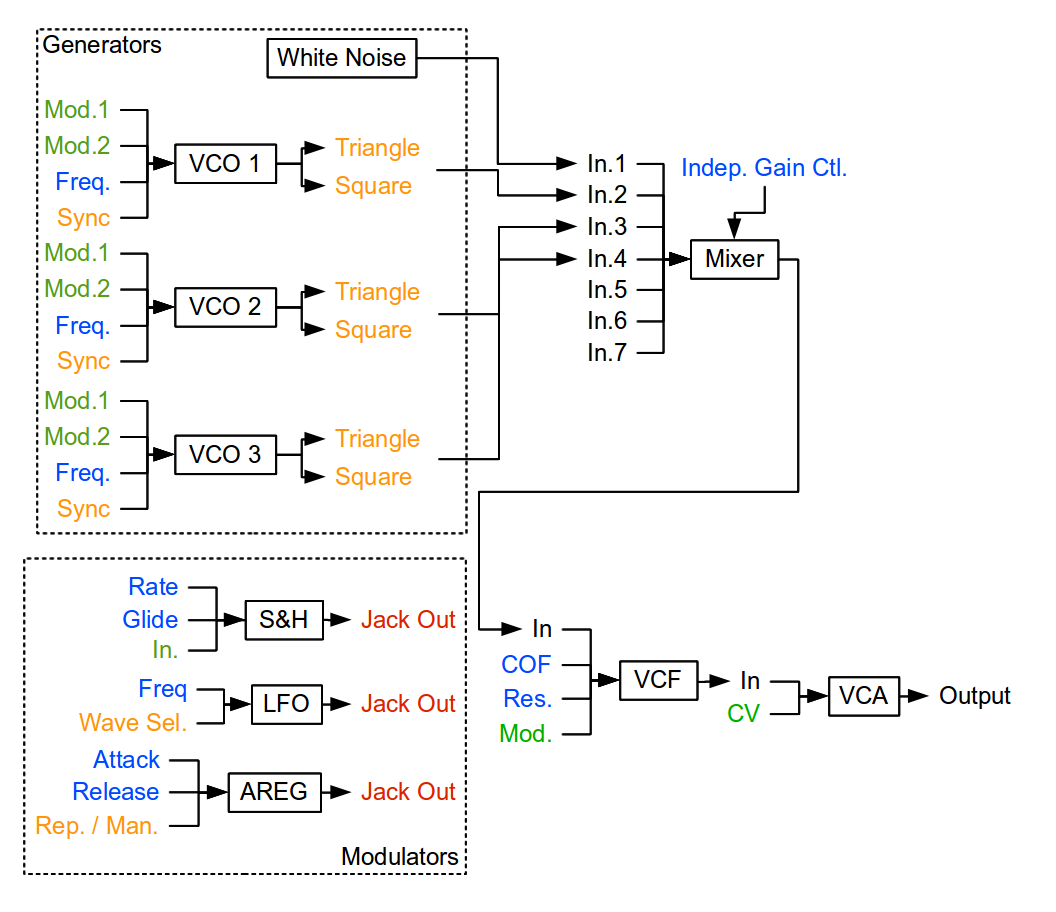Independent Study: Analog Synthesizer Design

In the framework on an independent study with Fernando Lopez-Lezcano, Tim O'Brien, Myles Borins, Kurt Werner, Gina Collecchia and I built our own analog synthesizers (a somewhat ironic thing to do at the Center for Computer Research in Music and Acoustics...). This report gives a brief overview of the work I've done so far for this project.
The Noise Toaster
As most of us were not familiar (or at least, not a lot) with the world of modular synths, we had to find a way to quickly get started. In order to be able to easily help each other, we chose to built the same synthesizer: the Noise Toaster described by Ray Wilson in Make: Analog Synthesizers. This book as well as its associated website: Music from Outer Space have been very useful resources for our project. We all built our own customized version of the Noise Toaster. For example Kurt, who had a more solid background in electronics than most of us, decided to design a more modular version of the Noise Toaster that he described on his website.
For my part, I ordered a kit on Music from Outer Space that included the PCB and the components to build a Noise Toaster. I designed in Inkscape my own box and front panel that I laser cut at the Stanford Product Realization Lab. It is made of acrylic plates (1/4” for the sides and the bottom and 1/8” for the top). The front panel is thinner in order to be able to easily attach the knobs, jack inputs and switches to it. Theoritically, the different parts of the box should hold themself together. However, screws and nuts can be added to make it more robust. The PCB can be mounted directly on the front panel which makes it easy to remove. The laser cut-able .ai or .svg files of this box can be downloaded here.


Upgrading the Noise Toaster
Part of this independent study was to get a good understanding of how analog synthesizers work. For this reason, I decided to upgrade my noise toaster with two new VCOs, a mixer and a sample and hold unit. While I'm still in the process of making all these new elements, I will give a short overview of the additions and modifications I'm making to the original circuit.
The VCOs
The two new oscillators are very similar to the Noise Toaster's VCO. The only difference is that they have two banana jacks that input any modulation signal coming from the LFO, the S&H, etc. I kept the knobs to control the amplitude of the modulation as well as the sync switch that is still linked to the LFO.
The Sample and Hold Unit
The sample and hold unit I'm adding to my Noise Toaster is the New Micro Sample n'Hold of Music from Outer Space. It is very simple and it can be used to control any of the VCOs or the VCF.
The Mixer
The mixer can mix up to seven signals together. The gain of each signal can be controlled with a knob. The three VCOs and the noise generator are connected to the first four inputs. The three other inputs will remain unused for now. The output of the mixer is connected to the VCF that can be modulated by the S&H, the LFO or the AREG. Finally, the VCA can also be modulated by any of these controllers.
The block diagram below gives an overview of my modified version of the Noise Toaster. The following color code is used:
- Green: input banana jacks and knobs for control signals
- Red: output banana jacks of control signals
- Blue: knobs
- Orange: switches

Video of Our Final Performance at the Bing Concert Hall with AnaLocos: Toast and Jam
Six Noise Toasters, each with 10 knobs to twist, 9 switches to throw (well, 10 if you count the on/off switch) and a button to push. Six humans moving all those controls in unexpected yet related ways. A bit of reverberation to spice things up. A computer (we have to have a computer, right?) that places those sounds inside an artificial soundscape in Bing. The result: a chaotically complex sound, noise and modulation world. The Ensemble AnaLocos (contraction of Analógicos Locos, roughly "Crazy Analogs") tries to keep them [under|out] of control in this directed improvisation. The old guy that seems to be out of place (the synthesizer of course) is El Dinosaurio, another analog synth built more than 30 years ago and still young at heart, sonically speaking. El Dinosaurio is maybe the inspiration that lead to 5 students (Romain, Tim, Myles, Gina & Kurt - in no particular order) synchronizing their "Independent Study" courses with Nando, finding this hardware project on their own, building them, and finally jamming together for a better world, or maybe just a noisier one (in a good way). A happy outcome.